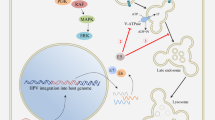Abstract
As mouse embryos develop they become susceptible to infection by the small DNA oncogenic viruses, simian virus 40 and polyoma1,2. Recently, the mouse teratocarcinoma, an alternative model system for the study of early development3,4, was used in an approach to understanding how differentiation affects host–virus interaction (ref. 5 and M.B. and F.K., unpublished). Several differential teratocarcinoma lines were shown to be fully permissive to polyoma virus and could be transformed by SV40, therefore reacting to viral infection like most commonly used mouse cells. In contrast, the multipotential embryonal carcinoma cells were resistant to both viruses and the block seems to lie early in the lytic cycle, after penetration of the virus, but before synthesis of the viral T antigen. Adenoviruses have much in common with the papovaviruses but are larger and more complex. We therefore examined the susceptibility of teratocarcinoma cells to these viruses. Here we report that both embryonal carcinoma cells and cells from a differentiated teratocarcinoma line are susceptible to adenovirus type 2.
This is a preview of subscription content, access via your institution
Access options
Subscribe to this journal
Receive 51 print issues and online access
$199.00 per year
only $3.90 per issue
Buy this article
- Purchase on Springer Link
- Instant access to full article PDF
Prices may be subject to local taxes which are calculated during checkout
Similar content being viewed by others
References
Solter, D., Biczysko, W., and Koprowski, H., in Viruses, Evolution and Cancer (edit. by Kurstak, E., and Maramorosch, K.), 3–30 (Academic, New York, 1974).
Dawe, C. J., in Tissue Interaction in Carcinogenesis (edit. by Tarin, D.), 305–358 (Academic, New York, 1972).
Jacob, F., in The Early Development of Mammals (edit. by Balls and Wild), 233–241 (Cambridge University Press, Cambridge, 1975).
Gail, R. M., Cell, 5, 229–243 (1975).
Swartzendruber, D. E., and Lehman, J. M., J. cell. Physiol., 85, 179–187 (1975).
Stevens, L. C., Devl Biol., 21, 364–382 (1970).
Jakob, H., Boon, T., Gaillard, J., Nicolas, J. F., and Jacob, F., Ann. Microbiol. (Inst. Pasteur), 124 B, 269–282 (1973).
Nicolas, J. F., Dubois, P., Jakob, H., Gaillard, J., and Jacob, F., Ann. Microbiol. (Inst. Pasteur), 126 A, 3–22 (1975).
Philipson, L., Virology, 15, 263–268 (1961).
Tooze, J., in The Molecular Biology of Tumor Virus (edit. by Cold Spring Harbor Laboratory), 420–469 (Cold Spring Harbor, New York, 1973).
Ginsberg, H. S., Ensinger, M. J., Kauffman, R. S., Mayer, A. J., and Lundholm, U., Cold Spring Harb. Symp. quant. Biol., 39, 419–426 (1974).
Author information
Authors and Affiliations
Rights and permissions
About this article
Cite this article
KELLY, F., BOCCARA, M. Susceptibility of teratocarcinoma cells to adenovirus type 2. Nature 262, 409–411 (1976). https://doi.org/10.1038/262409a0
Received:
Accepted:
Published:
Issue Date:
DOI: https://doi.org/10.1038/262409a0
This article is cited by
-
Immortalization of committed precursor cells from mouse teratocarcinoma using an adenovirus-SV40 recombinant plasmid
Methods in Cell Science (1995)
-
Restricted replication of adenovirus type 2 in mouse balb/3T3 cells
Archives of Virology (1986)
-
Lack of retrovirus gene expression in teratocarcinoma stem cells is limited to the nucleus
Somatic Cell Genetics (1982)
-
Embryonal carcinoma stem cells lack a function required for virus replication
Nature (1980)
-
Evidence for non-spliced SV40 RNA in undifferentiated murine teratocarcinoma stem cells
Nature (1979)
Comments
By submitting a comment you agree to abide by our Terms and Community Guidelines. If you find something abusive or that does not comply with our terms or guidelines please flag it as inappropriate.



